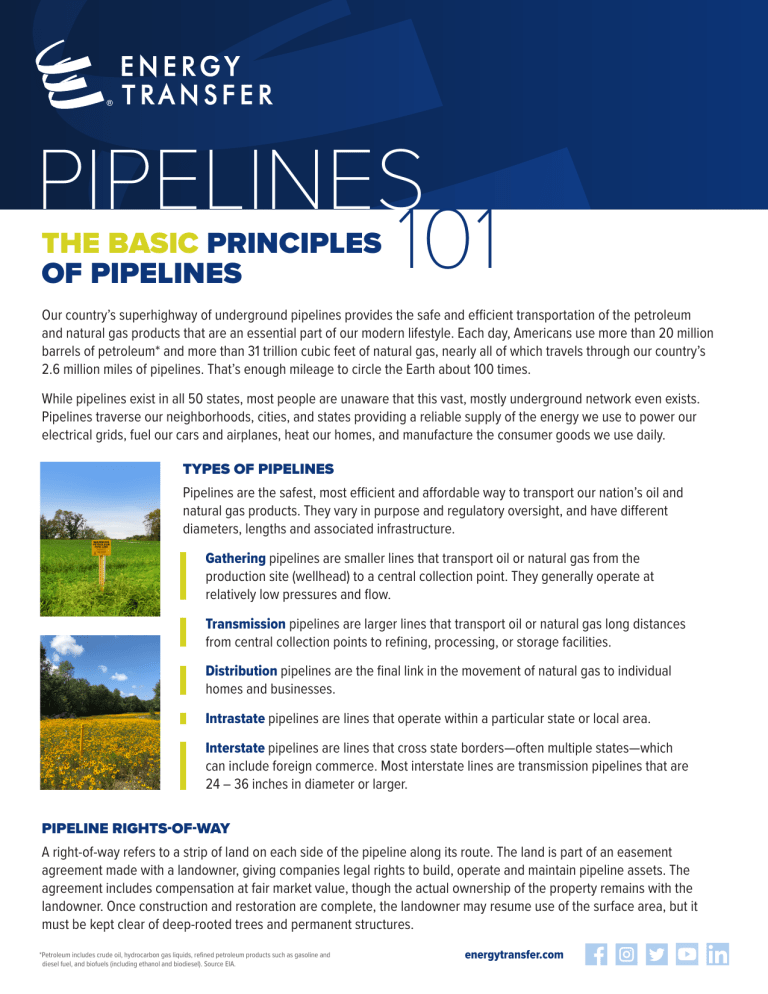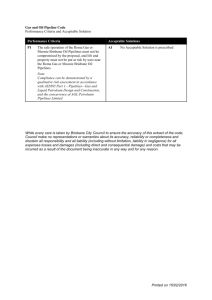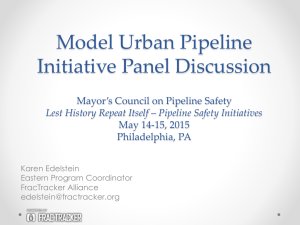
PIPELINES 101 THE BASIC PRINCIPLES OF PIPELINES Our country’s superhighway of underground pipelines provides the safe and efficient transportation of the petroleum and natural gas products that are an essential part of our modern lifestyle. Each day, Americans use more than 20 million barrels of petroleum* and more than 31 trillion cubic feet of natural gas, nearly all of which travels through our country’s 2.6 million miles of pipelines. That’s enough mileage to circle the Earth about 100 times. While pipelines exist in all 50 states, most people are unaware that this vast, mostly underground network even exists. Pipelines traverse our neighborhoods, cities, and states providing a reliable supply of the energy we use to power our electrical grids, fuel our cars and airplanes, heat our homes, and manufacture the consumer goods we use daily. TYPES OF PIPELINES Pipelines are the safest, most efficient and affordable way to transport our nation’s oil and natural gas products. They vary in purpose and regulatory oversight, and have different diameters, lengths and associated infrastructure. Gathering pipelines are smaller lines that transport oil or natural gas from the production site (wellhead) to a central collection point. They generally operate at relatively low pressures and flow. Transmission pipelines are larger lines that transport oil or natural gas long distances from central collection points to refining, processing, or storage facilities. Distribution pipelines are the final link in the movement of natural gas to individual homes and businesses. Intrastate pipelines are lines that operate within a particular state or local area. Interstate pipelines are lines that cross state borders—often multiple states—which can include foreign commerce. Most interstate lines are transmission pipelines that are 24 – 36 inches in diameter or larger. PIPELINE RIGHTS-OF-WAY A right-of-way refers to a strip of land on each side of the pipeline along its route. The land is part of an easement agreement made with a landowner, giving companies legal rights to build, operate and maintain pipeline assets. The agreement includes compensation at fair market value, though the actual ownership of the property remains with the landowner. Once construction and restoration are complete, the landowner may resume use of the surface area, but it must be kept clear of deep-rooted trees and permanent structures. *Petroleum includes crude oil, hydrocarbon gas liquids, refined petroleum products such as gasoline and diesel fuel, and biofuels (including ethanol and biodiesel). Source EIA. energytransfer.com PIPELINE VALVES AND FACILITIES Pipelines require the use of valves and associated above-ground facilities in order to safely move product down the line. Valves serve multiple safety and maintenance functions and can be used to stop the flow along a certain section of pipe. Both automated and manual valves are strategically placed at specific intervals along the pipeline route. Metering Stations are installed along a pipeline to measure the volume, flow rate and quality of the product in the pipeline. Pump Stations are above-ground facilities that keep oil products moving through the pipeline. They are typically 40 – 60 miles apart. The exact distance is determined by a variety of factors including engineering design, power availability, terrain and delivery needs. Compressor Stations are above-ground facilities that keep natural gas moving at a specific pressure and velocity through the pipeline. The size and number of compressors at each station is based on the diameter of the pipe, volume of gas being moved and elevation differences. A SCADA System (Supervisory Control And Data Acquisition) is a sophisticated control system that analyzes pipeline data including pressure, flow rates, temperature, and whether valves are open or closed. SCADA sensors can be installed at valve sites, metering stations, pump stations and compressor stations. Pump and compressor stations are typically located on several acres, most often with all mechanical equipment safely housed within thick-walled structures to reduce sound. They are designed, built and landscaped to minimize visual impact and to have redundant safety measures for added environmental protection. PIPELINE OPERATORS AND REGULATORS Pipelines in the U.S. are operated by approximately 3,000 companies, large and small. Pipeline operators are similar to mail carriers – they provide transportation but do not own the product or choose its final destination. Operators must abide by the numerous permits, licenses, registrations and certifications of the local, state and federal agencies that regulate pipelines. The federal government has the primary authority for pipeline safety regulations for both interstate and intrastate pipelines. The Pipeline and Hazardous Materials Safety Administration (PHMSA) within the U.S. Department of Transportation (DOT) is responsible for establishing and enforcing proper design, construction, operation, maintenance, testing and inspection standards for both oil and natural gas pipelines. The Federal Energy Regulatory Commission (FERC) also regulates pipelines, but in distinctly different ways. FERC has the authority to review and grant certificates for the construction and operation of interstate natural gas pipelines and facilities. FERC is also responsible for the regulation of tariffs that interstate oil pipeline companies charge for the transportation of product. Oil pipelines, however, are permitted by each state’s utility commission. Before pipelines are constructed, there are a myriad of permits and approvals that must be obtained from state and federal environmental agencies (e.g., wetlands, storm water, air, historic preservation, etc.) to ensure operations are conducted in a safe, secure and environmentally responsible manner.



